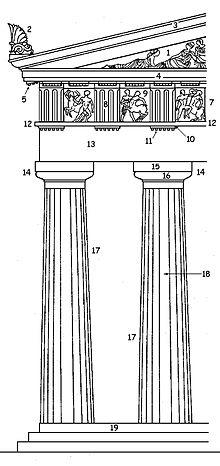In classical architecture, a sima is the upturned edge of a roof which acts as a gutter. Sima comes from the Greek simos, meaning bent upwards.
Form
The sima runs around all four sides of a building. The raking sima is continuous, while the simas on the other sides are broken by downspouts. Early simas feature tubular or half-cylindrical spouts, but these were mostly replaced with animal-head spouts by the middle of the 6th century BC.
Simas may be made of terracotta or stone.
Decoration
Simas are normally decorated. Stone simas have continuous narratives, especially on the raking sides where they are not interrupted by spouts, similar to a frieze. Terracotta simas have repeating patterns that are easy to reproduce with molds.
External links
![]() The dictionary definition of sima at Wiktionary
The dictionary definition of sima at Wiktionary

